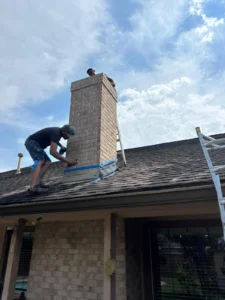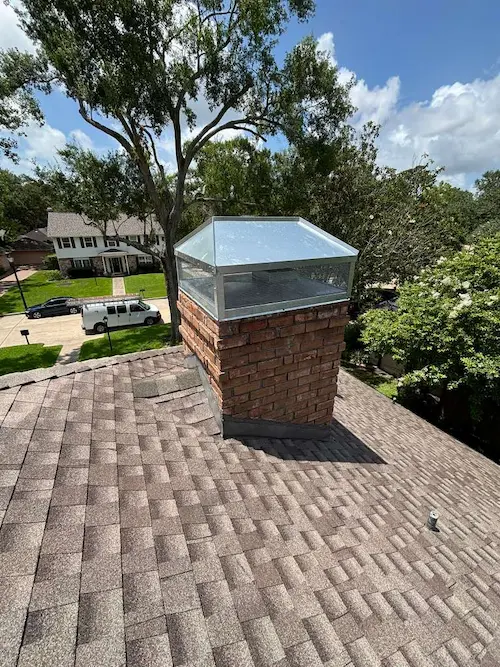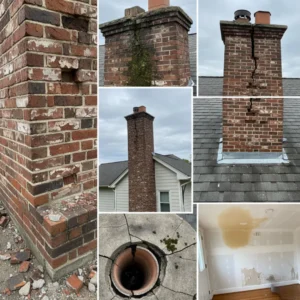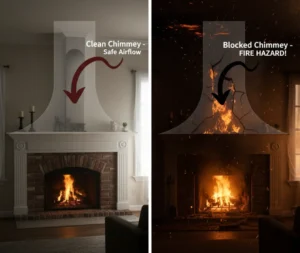Chimneys are built to handle heat, smoke, and weather, but in Houston, they face challenges that many homeowners don’t think about. The city’s climate is humid, stormy, and unpredictable. Between hot summers, sudden heavy rains, and hurricane season, chimneys here work harder than those in many other parts of the country.
Without proper care, Houston’s weather can cause serious damage to brick, mortar, and metal chimney parts. The result can be leaks, cracks, and unsafe conditions. Understanding how climate affects chimney health—and knowing what to do about it—helps you protect your home and avoid costly chimney repairs.
Houston’s Hot and Humid Summers 
One of the most obvious features of Houston’s climate is the heat. Long summers bring high temperatures and heavy humidity. These conditions can cause expansion in chimney materials. Bricks, mortar, and metal parts expand in the heat and contract when temperatures cool down at night. Over time, this constant movement weakens the structure.
Humidity adds another challenge. Moisture in the air settles on chimney surfaces, making them more vulnerable to mold and mildew. It also encourages rust on chimney flashing, caps, and dampers. If not treated, rust can spread and weaken these important parts.
What to Do: Homeowners should schedule regular chimney inspections, especially after long summers. Applying water-repellent sealants to bricks and mortar helps reduce moisture absorption. For metal components, protective coatings prevent rust from forming.
Heavy Rain and Storm Damage
Houston is known for sudden thunderstorms and periods of heavy rainfall. When water enters a chimney, it can cause major damage. Bricks are porous and soak up moisture like sponges. This leads to crumbling mortar, weakened walls, and stained interiors.
During storms, strong winds can blow rain directly into chimneys. If the chimney cap is missing or damaged, water flows straight down the flue. Once inside, moisture can damage the liner, create odors, and encourage mold growth.
What to Do: The best protection is a high-quality chimney cap. Waterproofing the chimney’s exterior with a breathable sealant adds another layer of defense. After major storms, homeowners should check their chimneys for leaks or seal leaky chimney issues.
Risks From Hurricanes and High Winds
Hurricane season is a real concern for Houston homeowners. High winds put extra pressure on chimneys, especially older or poorly maintained ones. Strong gusts can loosen bricks, shift flashing, or even knock chimney caps out of place. Flying debris may also strike the chimney, leaving cracks and structural damage.
What to Do: Before hurricane season, schedule a certified chimney inspection. Reinforcing weak mortar joints with chimney masonry repair and ensuring the cap is secure helps reduce storm damage. For added safety, some homeowners install hurricane straps or braces on larger chimneys.
Cool Winters and Fire Use
While Houston winters are mild compared to northern states, homeowners still enjoy using wood fireplaces during cooler months. Even occasional use creates soot and creosote buildup inside chimneys. Creosote is a flammable byproduct of burning wood, and if it isn’t cleaned out, it can cause chimney fires.
Cold nights also create condensation in chimneys. When warm smoke rises and meets cool air, moisture forms along the flue walls. Combined with Houston’s already humid environment, this moisture speeds up rust and brick decay.
What to Do: Have chimneys cleaned and inspected before winter. A professional sweep removes creosote and ensures the flue is clear of blockages. If needed, upgrades such as chimney relining help protect the structure.
Salt Air Near Coastal Areas
Houston’s location near the Gulf means some homeowners deal with salty air. Salt particles carried by wind speed up corrosion on metal chimney parts. Caps, dampers, and flashing are particularly vulnerable. Over time, this corrosion creates leaks and reduces efficiency.
What to Do: Stainless steel or copper chimney components last longer in salty air than standard galvanized steel. Regular maintenance and replacing weakened parts with durable options during chimney installation extend the life of your system.
Vegetation and Wildlife Challenges
The warm, humid climate in Houston also supports rapid plant growth and active wildlife. Vines and moss sometimes grow on chimney exteriors, holding moisture against the surface and leading to cracks. Birds, squirrels, and raccoons may try to nest inside chimneys, especially if the cap is damaged.
What to Do: Keep vegetation trimmed away from the chimney and install a properly fitted chimney cap with mesh siding. If animals or blockages occur, schedule commercial chimney cleaning for safe removal.
The Cost of Ignoring Climate Damage
If chimney damage from Houston’s climate is ignored, repairs can become very costly. Small cracks in mortar let in water that spreads through the structure. Rusty dampers eventually stop sealing, allowing drafts and leaks. Missing caps invite animals, debris, and stormwater.
In some cases, ignoring these problems leads to chimney fires, carbon monoxide leaks, or full chimney replacement. These issues cost far more than preventive care.
Professional Maintenance for Houston Homes
Because Houston’s climate is so tough on chimneys, professional maintenance is key. Certified technicians know how to spot structural issues, moisture damage, and creosote buildup before they escalate. An annual Level 1 chimney inspection should be part of every homeowner’s routine.
During inspections, professionals check for leaks, cracks, and fire risks. They may recommend waterproofing, chimney flashing replacement, or upgrades to keep chimneys working safely.
Long-Term Protection Strategies
Protecting chimneys in Houston requires a mix of prevention and care:
- Apply waterproofing sealants to exterior masonry every few years
- Replace damaged or rusted caps, dampers, and flashing quickly
- Use stainless steel liners in coastal areas
- Keep gutters and downspouts clear so rainwater doesn’t pool near the base
- Schedule regular cleanings to reduce creosote buildup
These steps keep chimneys strong despite Houston’s climate.
Conclusion: Protecting Chimneys in Houston Weather
Houston’s climate brings heat, humidity, storms, and even salty air—all of which put stress on chimneys. Left unchecked, these conditions lead to cracks, leaks, rust, and unsafe fireplace systems. But with regular inspections, professional cleanings, and preventive upgrades, homeowners can avoid costly repairs and keep their chimneys in excellent shape.
For Houston homeowners, chimney care is more than routine maintenance—it’s protection against the climate itself. By acting early and staying consistent, you keep your home safe, your fireplace efficient, and your investment secure for years to come.
Houston’s Humidity Is a Chimney’s Worst Enemy
Houston’s humid, subtropical climate creates unique challenges for chimney health. While you might not use your fireplace year-round, your chimney is constantly exposed to moisture, which can lead to a host of problems including:
- Creosote Buildup: High humidity combined with smoky fires can accelerate the buildup of creosote—a highly flammable substance that is the leading cause of chimney fires.
- Water Damage: Houston’s heavy rainfall can seep into a chimney with a cracked crown or damaged flashing, leading to structural damage, mold growth, and rust on the damper or firebox.
- Spalling Masonry: The constant cycle of heat, moisture, and cooling can cause the bricks to absorb water, leading to their faces popping or flaking off—a process known as spalling.
At Texas Chimney LLC, we handle everything from fireplace remodeling and gas fireplaces to air duct cleaning and dryer vent cleaning.
Don’t let Houston’s climate compromise your home. Contact us today for a professional inspection and a custom plan to protect your chimney!





